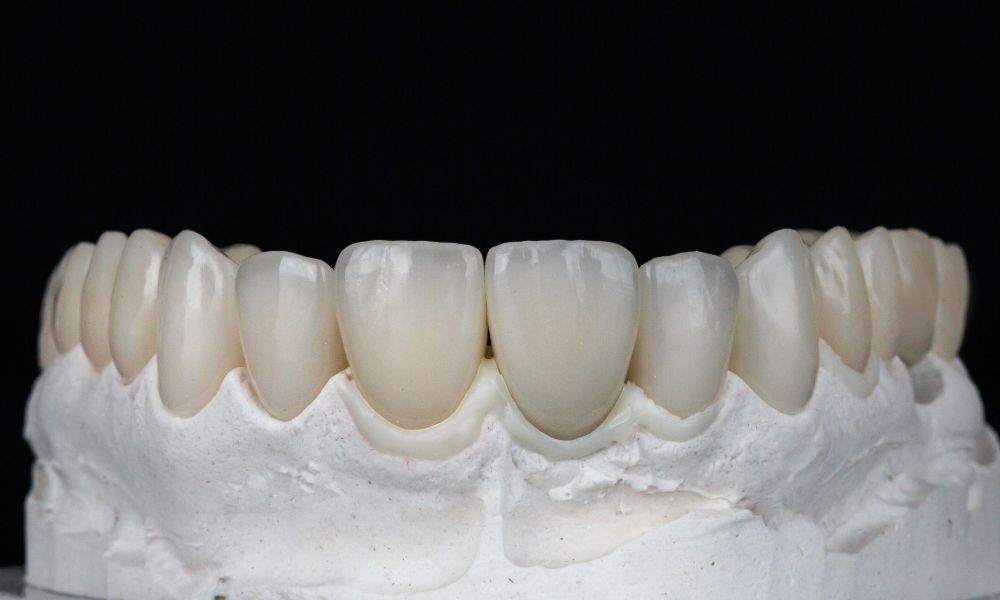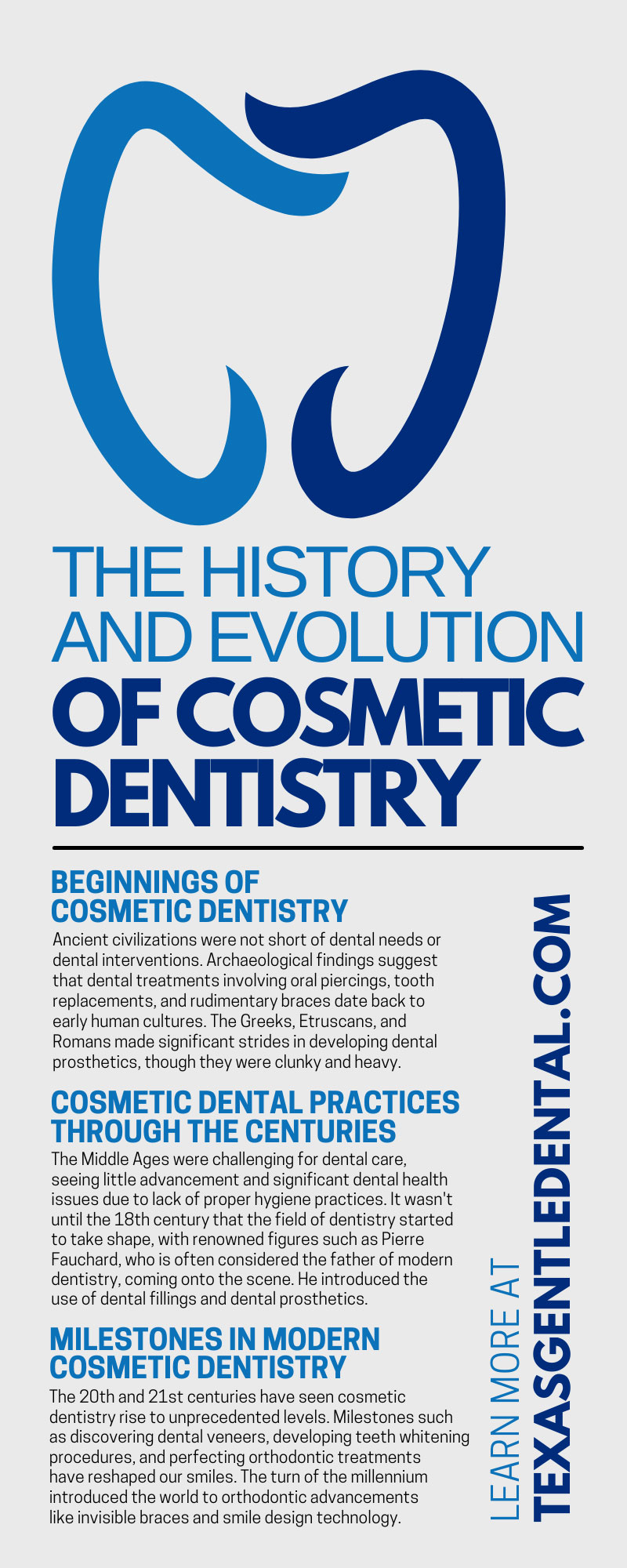The History and Evolution of Cosmetic Dentistry

Cosmetic dentistry has undergone a remarkable transformation over the years, evolving from a rudimentary practice of necessity to a blend of art and science. The modern smile is a testament to human ingenuity and our pursuit of better dental care. Whether you’re seeking to achieve the perfect smile or simply curious about the fascinating history of dental aesthetics, follow this deep dive into the history and evolution of cosmetic dentistry. Explore the milestones, advancements, and current trends that define the realm of cosmetic dental care.
What Is Cosmetic Dentistry?
Cosmetic dentistry is any dental work that addresses a person’s teeth, gums, or bite placement to alter their appearance. It focuses on enhancing dental aesthetics to improve the appearance of the smile. Procedures can be as simple as teeth whitening or as complex as a complete smile transformation spanning multiple dental procedures.
This genre of dentistry, also known as smile design, is not just about vanity. A person’s smile can have a huge impact on their perception of their appearance and their self-confidence. It affects an individual’s confidence, social interactions, and personal and professional growth. For patients, it’s an investment in their health and happiness.
Importance of Cosmetic Dentistry in Healthcare
Cosmetic dentistry often intersects with general dentistry and other specialized areas such as orthodontics, periodontics, prosthodontics, and oral surgery. It is essential in restoring functionality and oral health, fulfilling a broader healthcare mandate.
Cosmetic dentistry may address issues such as dental cavities, missing teeth, cracked or chipped teeth, and decayed teeth if they impact the overall smile. By providing solutions to these pressing concerns, cosmetic dentistry ensures patients can enjoy a better quality of life, free from pain, discomfort, and the burden of oral imperfections.
Beginnings of Cosmetic Dentistry
Ancient civilizations were not short of dental needs or dental interventions. Archaeological findings suggest that dental treatments involving oral piercings, tooth replacements, and rudimentary braces date back to early human cultures. The Greeks, Etruscans, and Romans made significant strides in developing dental prosthetics, though they were clunky and heavy.
Early Chinese civilizations were the first to document and practice dental care, employing materials like bamboo and stones to create some of the earliest forms of toothbrushes and dental drills. Despite the less-than-sterile environment and primitive tools, these early cosmetic dental practices laid the foundation for what would come.
Cosmetic Dental Practices Through the Centuries
The Middle Ages were challenging for dental care, seeing little advancement and significant dental health issues due to lack of proper hygiene practices. It wasn’t until the 18th century that the field of dentistry started to take shape, with renowned figures such as Pierre Fauchard, who is often considered the father of modern dentistry, coming onto the scene. He introduced the use of dental fillings and dental prosthetics.
By the 19th century, dentists began using gold and amalgam for fillings and porcelain for dental prosthetics. Porcelain veneers were a breakthrough in achieving a natural look for dental enhancements. The 1950s saw the emergence of bonding and implant dentistry, providing aesthetic solutions no one could have imagined in the early days of dentistry. The turn of the 20th century brought tooth-colored composites to center stage, revolutionizing the appearance of dental work.
Milestones in Modern Cosmetic Dentistry
The 20th and 21st centuries have seen cosmetic dentistry rise to unprecedented levels. Milestones such as discovering dental veneers, developing teeth whitening procedures, and perfecting orthodontic treatments have reshaped our smiles. The turn of the millennium introduced the world to orthodontic advancements like invisible braces and smile design technology. These milestones have transformed our smiles and revolutionized the way we approach dental aesthetics and oral health.
Advances in Technology and Materials
The digital age ushered in a golden era for cosmetic dentistry. Cutting-edge technologies such as 3D imaging, computer-aided design and computer-aided manufacturing (CAD/CAM), and laser dentistry have made procedures more accurate, efficient, and comfortable for patients.
The materials used in cosmetic dental work have also undergone revolutionary changes. High-strength ceramics offer durability and aesthetics that were previously unattainable, while tooth-colored restorations continue to blur the line between what’s real and what’s not. These advancements help patients regain confidence in their appearances and in themselves.
Current Trends in Cosmetic Dentistry
The field of cosmetic dentistry continues to evolve, offering a range of benefits to patients seeking aesthetic improvements. In modern times, there is a growing emphasis on tailoring treatments to individual needs, employing techniques that are gentle on the teeth and gums, and adopting environmentally friendly approaches.
Digital smile design has become a standard part of pre-treatment planning, allowing patients to preview their new smiles before dentists alter anything physically. Minimally invasive dentistry techniques preserve more of the natural tooth structure, resulting in longer-lasting, more efficient restorations.
Impact on Dental Patients
For millions of individuals worldwide, the transformative effects of cosmetic dentistry are profound. Beyond enhancing the aesthetics of smiles, this branch of dentistry has ushered in a new era of holistic well-being for patients.
Through aesthetic dental procedures, individuals can experience a remarkable enhancement in their self-esteem and confidence levels that yields a positive ripple effect on their social interactions and professional endeavors. By addressing dental imperfections, patients can liberate themselves from their smile-related insecurities, paving the way for newfound courage and empowerment. This newfound sense of assurance often acts as a catalyst for broader opportunities and fosters a more optimistic outlook on life’s possibilities.
Benefits of Cosmetic Dentistry
Beyond the obvious aesthetic improvements, many cosmetic dental procedures also provide functional benefits. Orthodontic treatments straighten teeth, improving a person’s ability to bite and chew effectively. Dental implants offer sturdy replacements for missing teeth, restoring the ability to eat comfortably and speak clearly. Veneer cosmetic dentistry offers flexible solutions for a variety of tooth troubles, including broken or displaced teeth.
A perfect smile is not just about looking good; these orthodontic treatments have as many functional benefits as they do aesthetic ones. This dual emphasis on form and function distinguishes modern cosmetic dentistry and makes it a vital part of comprehensive oral healthcare.
The history and evolution of cosmetic dentistry is a tale of endless innovation and unwavering commitment to serving patient needs. From the archaic methods of our ancestors to the sophisticated techniques of contemporary dentistry, the goal has remained the same: to bring a bright and beautiful smile to every face.
Cosmetic dentistry continues to push boundaries, integrate new technologies, and redefine what is possible. If you’ve been inspired by this walk through cosmetic dentistry history and want to invest in your own smile, start your journey with Gentle Dental Care. We provide a wide range of cosmetic and general dentistry procedures, including everything from teeth whitening to veneers. Explore our website today to learn more.
